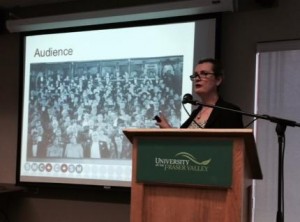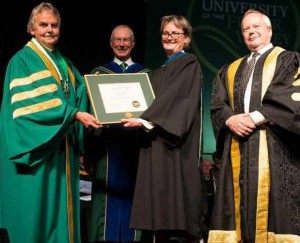
Last week, the University of the Fraser Valley brought one of their honourary doctorate recipients, Dr Penny Park from the Science Media Centre of Canada, back to campus to speak about the urgent need to communicate science in Canada.
Penny called for scientists to “step up”and correct misinformation when they saw it. She spoke about instances where public misinformation in Canada had exponentially grown; citing recent examples of climate change, genetic engineering, and vaccinations.
“Scientists want to weigh things up, to take their time to think about things; but communication is speeding up,” Penny said.
“You [scientists] have an obligation to reach out to the public beyond your organisation’s boundaries. We need you,” she added.
Penny referred to an EKOS research poll from 2011 showing that Canadians trust scientists more than they trust a lot of other groups, including politicians.
“Be terrier like. If you see something that is inaccurate, do something about it.”
She also answered audience questions about the practicalities of engaging with the public. Rather than “dumbing down” research for the public, she essentially called on researchers to challenge people with their ideas rather than their language.
“Consider how your work might enter a conversation that is already happening,” she urged.
In an earlier blog post, I referred to a talk by Jim Hoggan, from Hoggan and Associates, who warned that researchers were in danger of contributing negatively to already polarised public debates. I asked Penny if researchers might be contributing more noise to already noisy issues. Her response was for scientists to use trusted channels of communication, such as the Science Media Centre of Canada or start their own blog or Twitter site where they could establish credibility with a following before an issue became a problem.

Penny also responded to questions about what “sells” science to the public. She advised scientists to consume the media where they would like to publish so that they could appreciate what that community of viewers or readers needs to know. This also serves to get to know what the editors like. She cited what she referred to as the “NASA School of Journalism”, which has brought space to the world through images and animations
“Canadians love weather and sex,” she said. “Animal sex always makes a great story.”
UFV President, Mark Evered, asked Penny about communicating research before peer review. He was concerned that communicating too early could damage the reputation of scientists and science in general. Penny responded that it is the duty of scientists not to oversell what they’ve got.
She also called for journalists as well as public readers and viewers, to look critically at the information they are presented with.
“Critical thinking is the key,” she emphasized.
Penny ended the President’s 2014 Leadership Lecture with a call to for UFV to engage students in critical thinking around numeracy and statistics.
“Make it attractive and they’ll want to learn more,” she said.

